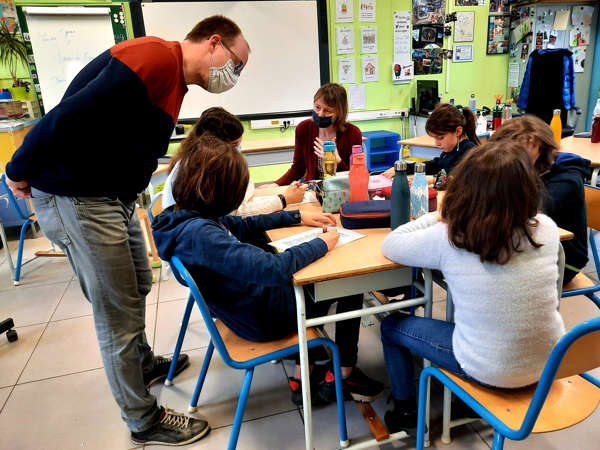An entire classroom or nursery group may have to go into quarantine if there are several infections among the group's students, or if a child care worker or teacher tests positive.
This decision can be taken if it is impossible to identify high-risk contacts within the group, or if a wider circulation of the virus within the student or nursery group is suspected, according to the latest guidance from the health institute Sciensano.
"If a class is closed due to widespread circulation of the virus within it, the quarantine period for all students starts from the first day of the class closure," the guidance read.
According to Sciensano, if a teacher in primary education tests positive, the pupils will normally be considered high-risk contacts, as "the teacher is walking around, and cannot always keep his/her distance and face masks are not recommended in primary schools."
An analysis will be carried out by the services for preventive health care at schools (Centra Voor Leerlingenbegeleiding in Dutch-speaking schools, Services de Promotion de la Santé à l'École for French-speaking education and Kaleido for the German-speaking community).
The services will then have to assess the risk that that infected person can infect others and then has to decide whether the class should be quarantined or not, Ria Vandenreyt of the Agency for Care and Health told Belga news agency.
Related News
- More than 2,000 daily coronavirus infections on average
- Almost 3,000 people left private sector to become teachers in Flanders
- Covid infections between fully vaccinated people reduced by 90%
If two pupils in the same class become infected within 14 days and the class has not already been closed, the class will - in most cases - be closed for 7-10 days, unless the epidemiological investigation shows that the infections were probably contracted outside the classroom.
However, if detailed risk analysis is possible, only those pupils who had an exposure of more than 15 minutes at less than 1,5 metres of distance are considered as high-risk contacts. If a risk has been identified, all high-risk contacts will have to be tested.
Low-risk contacts
Meanwhile, in the case of one infected child or pupil in primary school and nurseries, the other classmates, as well as the teacher, are considered low-risk contacts, meaning they only need to be tested if they show symptoms and they do not need to isolate.
In secondary schools, if a child was in close contact with an infected person for longer than 15 minutes, they will be considered low-risk contacts if both parties wore face masks for the entire time.
"These individuals may continue to attend school and carry on with their usual activities, but should avoid contact with individuals at increased risk of serious disease progression (e.g. grandparents)," the advice stated.
Previously, fully vaccinated people were exempt from quarantine after a high-risk contact if they received a negative result from their initial test, however, they will now have to undergo another test seven days after the last risk contact.
Vaccinated people, if they have undergone the initial test, will not have to go into quarantine for the period between both tests.
On Tuesday, rules changed in a similar manner for unvaccinated travellers who do not have a valid vaccination or recovery certificate and are returning from a red zone in the EU, as they will now have to be tested twice upon arrival in Belgium, but can leave quarantine after the first negative test result.
Meanwhile, travellers who return from a red zone outside the EU must be tested on days 1 and 7 upon arrival in Belgium, even if they have a valid vaccination or recovery certificate.
In both cases, if the test result is negative on day 1, no quarantine is required. However, the second test (on day 7) is required regardless of the outcome of the first one. If the test is positive, self-isolation is obligatory.

